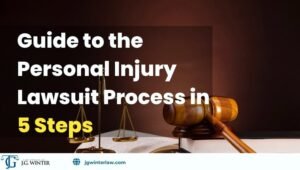For most people, the word “lawsuit” brings to mind images of courtroom drama and confusing legal battles. It sounds intimidating, expensive, and stressful—especially when you’re already dealing with the pain and anxiety of an injury. The fear of the unknown can prevent people from seeking the justice they deserve, leaving them to struggle with medical bills and lost wages while insurance companies take advantage of their uncertainty.
The truth is, the personal injury litigation process is a highly structured journey with predictable stages. While every case has its unique aspects, the overall path follows a well-established roadmap that attorneys navigate every day. Our goal here is to pull back the curtain and walk you through that journey, step by step, so you know exactly what to expect.
Understanding this process can transform it from something mysterious and frightening into something manageable and logical. While the timeline can vary—some cases resolve in months, others take years—knowing what lies ahead helps reduce anxiety and allows you to make informed decisions about your case.
Phase 1: The Foundation (Before a Lawsuit is Ever Filed)
The most critical work in a personal injury case often happens long before anyone steps foot in a courtroom. In fact, the vast majority of cases never make it to court at all. This initial phase is about building a strong foundation and attempting to resolve your case without the need for formal litigation.
Initial Consultation & Investigation
Your journey begins with an initial consultation with a personal injury attorney. This meeting, sometimes offered free of charge, allows both you and the attorney to evaluate whether you have a viable case and whether you’re a good fit for each other. During this meeting, you’ll tell your story, ask questions, and learn about your legal options.
If you decide to hire the attorney, they immediately begin a deep investigation into your case. This isn’t just about gathering a few documents—it’s about building a comprehensive picture of what happened and how it has affected your life. Your legal team will collect police reports, medical records, witness statements, and photographs of the accident scene. They might hire accident reconstruction experts to analyze how the incident occurred or medical experts to evaluate the extent of your injuries.
This investigation phase is crucial because evidence can disappear quickly. Surveillance footage gets overwritten, witnesses’ memories fade, and physical evidence at accident scenes changes or vanishes. A thorough early investigation preserves critical evidence that could make or break your case.
Reaching Maximum Medical Improvement
One of the most important concepts in personal injury law is “Maximum Medical Improvement” or MMI. This is the point at which your doctor determines that your condition has stabilized and is unlikely to improve significantly with additional treatment. You might not be fully healed—many people live with permanent effects from their injuries—but you’ve reached a point where the medical picture is clear.
Why does this matter? Because you and your lawyer need to understand the full extent of your injuries, treatment needs, and future medical requirements before demanding a settlement. If you settle too early and later discover your injuries are more severe than initially thought, you cannot go back and ask for more money. The settlement is final.
This doesn’t mean you have to wait until you’re completely healed to pursue your case. It means waiting until medical professionals can accurately assess your long-term prognosis. For some injuries, this might be a few months. For others, particularly traumatic brain injuries or complex orthopedic injuries, it could be a year or more.
The Demand Letter & Negotiation
Once your damages are known and documented, your attorney drafts a comprehensive “demand package.” This is much more than a simple letter—it’s often a detailed document that can run dozens of pages, accompanied by extensive supporting documentation.
The demand letter tells your story from beginning to end. It outlines the facts of the accident, proves the other party’s fault (what lawyers call “liability”), details all your damages including medical bills, lost wages, and pain and suffering, and demands a specific settlement amount. This number isn’t pulled from thin air—it’s based on careful analysis of your actual damages, similar case results, and the specific circumstances of your situation.
This demand letter kicks off a period of negotiation with the insurance company. They might respond with a counteroffer, dispute certain aspects of your claim, or request additional information. Your attorney will handle these negotiations, pushing for a fair settlement while keeping you informed of significant developments.
Here’s an important statistic: the vast majority of personal injury cases—over 95%—are settled during this negotiation phase without ever filing a lawsuit. Insurance companies often prefer to settle rather than risk the uncertainty and expense of trial. However, this only works when they know your attorney is willing and able to take the case to court if necessary.
Phase 2: Filing the Lawsuit & Getting Started
If the insurance company refuses to offer a fair settlement during negotiations, your attorney will recommend filing a lawsuit. This doesn’t mean you’re definitely going to trial—many cases still settle after a lawsuit is filed—but it formally moves your case into the court system and puts additional pressure on the insurance company.
Filing the Complaint
The lawsuit begins with a document called the “Complaint.” This legal document, prepared by your attorney and filed with the court, formally begins the lawsuit. The Complaint identifies all the parties involved (you as the plaintiff, the person or company you’re suing as the defendant), explains the legal basis for your claim, describes what the defendant did wrong, and details the harm you’ve suffered as a result.
The Complaint also specifies what you’re asking the court to do—typically, to award you monetary damages to compensate for your injuries. Your attorney will ensure the Complaint is properly drafted to include all viable legal claims and preserve your rights throughout the litigation.
Serving the Defendant
After filing the Complaint with the court, the defendant must be formally notified that they’re being sued. This process, called “service of process,” involves delivering a copy of the Complaint and a summons to the defendant. The summons is an official court document that tells the defendant they must respond to the lawsuit within a specific timeframe, typically 20 to 30 days.
Service must be done properly according to strict legal rules. Usually, a professional process server or sheriff’s deputy hand-delivers the documents to the defendant. This formal notification ensures the defendant can’t claim they didn’t know about the lawsuit.
The Answer
Once served, the defendant’s attorney files an “Answer” with the court. This document responds to each allegation in your Complaint, either admitting, denying, or stating they lack sufficient information to admit or deny each claim. The Answer might also include “affirmative defenses”—legal arguments about why the defendant shouldn’t be held liable even if the facts are as you’ve stated them.
Sometimes, the defendant files additional documents along with their Answer, such as a motion to dismiss certain claims or a counterclaim against you. Your attorney will handle all these legal maneuvers, explaining to you what they mean and how they affect your case.
Phase 3: The Discovery Process (Uncovering the Facts)
Discovery is often the longest and most intensive phase of litigation. It’s the formal process where both sides exchange all relevant information and evidence. The goal is to ensure there are no surprises at trial—both sides should know what evidence exists and what witnesses will say.
This phase can feel invasive and tedious, but it’s absolutely crucial to building a strong case. The insurance company’s lawyers will dig deep into your claim, and your attorney will do the same with their defenses. This thorough examination often reveals information that strengthens your position or exposes weaknesses in the defendant’s arguments.
Written Discovery
The discovery process typically begins with written discovery tools:
Interrogatories are written questions that each side sends to the other, which must be answered in writing and under oath. These might include questions like “List all medical providers you have seen since the accident” or “Describe in detail how the accident occurred.” While some questions might feel intrusive, your attorney will help you answer them appropriately and object to any that are improper or irrelevant.
Requests for Production of Documents are formal requests for physical evidence and documents. You might be asked to provide copies of all your medical bills, tax returns to prove lost wages, or photographs of your injuries. Similarly, your attorney will request documents from the defendant, such as a trucking company’s driver logs and maintenance records, or a property owner’s inspection reports.
Requests for Admission are written statements that the other party must either admit or deny. These help narrow down the facts that are actually in dispute. For example, your attorney might ask the defendant to admit that they were driving the vehicle that struck you, or that they owned the property where you fell.
Depositions
Depositions are perhaps the most important and nerve-wracking part of discovery for clients. A deposition is out-of-court testimony given under oath in front of a court reporter who creates a written transcript of everything that’s said. It’s like testifying at trial, but in a conference room rather than a courtroom.
You will likely have to give a deposition where the defendant’s attorney asks you questions about the accident, your injuries, your medical treatment, and how the injuries have affected your life. This can feel intimidating, but remember: your attorney will be right there with you, will prepare you thoroughly beforehand, and can object to improper questions.
Your attorney will also take depositions of the defendant and other important witnesses. This is a powerful tool for learning what the other side will say at trial and locking them into their story. If they change their testimony at trial, your attorney can use the deposition transcript to show they’re not being truthful.
The deposition phase also often includes depositions of expert witnesses. These might include accident reconstruction specialists, medical experts, economists who calculate lost earnings, or other professionals whose testimony supports your case.
Phase 4: Mediation & Late-Stage Negotiation
As the trial date approaches and both sides have completed discovery, the court often requires the parties to attempt mediation. Even if not required, many attorneys recommend it as a final opportunity to resolve the case without the risk and expense of trial.
What is Mediation?
Mediation is a confidential settlement conference where both sides meet with a trained, neutral mediator—often a retired judge or experienced attorney who specializes in helping parties reach agreements. The mediator doesn’t decide who wins or loses. Instead, they facilitate negotiation by helping each side understand the strengths and weaknesses of their case and find common ground.
The process typically begins with everyone in the same room as the mediator explains the process and each side briefly presents their view of the case. Then, the parties separate into different rooms, and the mediator shuttles between them, carrying offers and counteroffers, discussing the risks of trial, and working to bridge the gap between the parties’ positions.
Why Mediation Works
Mediation is remarkably effective, resolving a high percentage of cases that reach this stage. There are several reasons for its success. First, by this point in the litigation, both sides have a clear picture of the evidence and can make realistic assessments of their chances at trial. Second, the mediator brings a neutral perspective that can help break through the adversarial dynamics that sometimes prevent settlement. Third, mediation gives you control over the outcome—you can accept or reject any proposed settlement, whereas at trial, you’re bound by whatever the jury decides.
At firms like Cheney Galluzzi & Howard, attorneys prepare extensively for mediation, creating persuasive presentations that highlight the strengths of your case while being realistic about potential challenges. This preparation often makes the difference between a successful mediation and an impasse.
Phase 5: Trial (If a Settlement Can’t Be Reached)
If mediation fails and the insurance company still refuses to offer fair compensation, your case proceeds to trial. It’s important to understand that reaching this stage is rare—fewer than 5% of personal injury cases ever see the inside of a courtroom. When cases do go to trial, it’s usually because the insurance company is being unreasonable or the parties have fundamentally different views of liability or damages that can’t be reconciled.
The Trial Process
Jury Selection begins the trial. Attorneys for both sides question potential jurors to select a fair and impartial panel. Your attorney looks for jurors who can relate to your situation and will fairly evaluate the evidence, while excluding those who might be biased against personal injury lawsuits.
Opening Statements follow, where each attorney presents a roadmap of their case to the jury. Your attorney tells your story, outlines the evidence they’ll present, and explains why the law entitles you to compensation. This is the jury’s first impression of your case, so it’s crucial to present a clear, compelling narrative.
Presenting Evidence is the heart of the trial. Your attorney presents your case through witness testimony, documents, photographs, and other evidence. You’ll likely testify about the accident and how it has affected your life. Your doctors might testify about your injuries and treatment. Expert witnesses might explain how the accident occurred or calculate your economic losses. The defense then presents their evidence, which your attorney will challenge through cross-examination.
Closing Arguments give each attorney a final opportunity to argue their case to the jury. Your attorney weaves together all the evidence into a compelling argument for why you deserve compensation and how much you should receive.
Jury Deliberation and Verdict conclude the trial. The judge instructs the jury on the applicable law, and they retire to deliberate in private. They must decide whether the defendant is liable and, if so, how much to award in damages. Once they reach a verdict, they return to the courtroom to announce their decision.
After the Trial
Even after a jury verdict, the case might not be over. The losing party can file post-trial motions asking the judge to change the verdict or order a new trial. They might also appeal to a higher court, which can add months or years to the process. Your attorney will advise you on the likelihood of success of any appeals and help you decide whether to accept a post-trial settlement offer or continue fighting.
Understanding Timelines and Managing Expectations
One of the most common questions clients ask is “How long will this take?” The honest answer is that it varies tremendously based on numerous factors. A straightforward case with clear liability and moderate injuries might settle in six months. A complex case involving serious injuries, disputed liability, or multiple parties could take two to three years or more if it goes to trial.
Several factors affect the timeline. The severity of your injuries determines how long you must wait to reach maximum medical improvement. The court’s schedule affects how quickly your case moves through litigation—some jurisdictions have significant backlogs. The defendant’s approach matters too—some insurance companies are more reasonable than others. The complexity of legal or factual issues can extend the timeline, as can the number of parties involved.
While the wait can be frustrating, especially when you’re facing mounting bills, remember that patience often leads to better outcomes. Insurance companies count on financial pressure to force quick, cheap settlements. Having an attorney who can advance case costs and who has the resources to see your case through trial levels the playing field.
Your Attorney is Your Navigator
The legal system is complex, but it is not chaotic. It’s a series of logical steps designed to uncover the truth and achieve a fair result. While the litigation process can seem overwhelming when viewed as a whole, remember that you don’t have to navigate it alone.
An experienced personal injury attorney manages these steps, handles the deadlines, and deals with the insurance company’s lawyers. They know when to push forward and when to be patient, when to negotiate and when to stand firm. They prepare you for each stage, explaining what’s happening and why, so you’re never in the dark about your own case.
Your job through this process is to focus on what truly matters: your health, your family, and your recovery. Follow your doctor’s treatment recommendations, be honest and responsive with your attorney, and trust the process. Understanding the road ahead is the first step in reducing the anxiety of the unknown and taking back control after an injury has disrupted your life.
The personal injury litigation process isn’t just about money—it’s about accountability, justice, and ensuring you have the resources you need to move forward. While the journey might be longer than you’d like, having a skilled advocate by your side makes all the difference in reaching a fair and just destination.
About Cheney, Galluzzi & Howard: Cheney, Galluzzi & Howard is a Denver-based personal injury law firm dedicated to helping real people navigate the challenges that follow serious injuries. With decades of combined experience, the firm combines tenacious advocacy with genuine compassion to help clients rebuild their lives.
If you have questions about your injury case or would like to learn more about your legal options, contact a qualified personal injury attorney for a consultation. The information in this article is for educational purposes and should not be considered legal advice for your specific situation.







